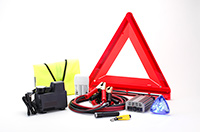Posted on 8/31/2017

This kit is intended to aid you in getting help, signaling your car’s presence to other motorists, and tackling simple challenges. Even if you have roadside assistance coverage or an automobile club membership with roadside assistance, you usually need access to a phone in order to contact them, and you may have to wait on the side of the road for an hour or more before help arrives. That’s why we recommend that drivers carry certain items in their vehicle, even if it only gets used for everyday, around-town driving. This basic kit can be supplemented with additional items if you go on a long-distance trip or have to deal with winter weather conditions. Cellular phone and travel charger – keep an old, fully-charged cell phone in your glovebox for back-up; inactive cell phones can still be used to call 911. First aid kit – be sure you know how to use it. Warning light, hazard triangle, or flares. Tire gauge – use this on a monthly basis to check ... read more
Posted on 4/25/2017

Fall is back to school and back to work time. That means returning to a crazy schedule of activities and commitments for you and your family. Make sure your hybrid won't let you down by following these important tips to keep it performing in top-notch condition. 1. Change Your Oil and Filters & Have Your Brake Pads Checked Like regular gas engines, hybrid and hybrid-electric vehicles need regular oil and filter changes. However, they don't need them as often because the electric components take some of the load off the engine. Our recommendation is to change your oil between 5,000 and 10,000 miles and your air filter every 40,000 miles. It's also a good idea to have your brake pads checked at the same time. The good news is that the regenerative braking properties of your car mean that your brake pads need to be replaced less frequently than those on a standard gas-powered car, but you want to be safe on the road, so make sure your technician gives ... read more
Posted on 11/1/2016
Winter is right around the corner, and with it, frigid temperatures and precipitation that make the trek to work treacherous. Cold temperatures are hard on cars and especially so on cars that have a hybrid battery. Here are some winter maintenance tips for to keep your hybrid vehicle performing in the cold. Park It Inside Cold temperatures and a hybrid battery do not act well together. Keeping your hybrid vehicle in a garage, even if it is not heated, will maintain the battery from feeling the brunt of freezing temperatures and the biting wind. This will make starting the car in the morning easier on the battery. It may not make a huge difference in performance, but every degree of warmth surrounding the car, the better because it will make the battery work less on keeping warm. Keep It Plugged In if You Own a PHEV or Plug-In EV Hybrid vehicles that require being plugged in should be left plugged in during the winter. This may seem counter intuitive, especially when the battery is ... read more